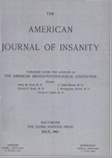METRAZOL SHOCK TREATMENT
Abstract
This report is concerned with a pharmacologic and metabolic study of metrazol convulsive therapy in human subjects. It was found that the level of serum calcium and potassium remained almost unchanged before and after convulsive seizures. The characteristic increase in blood sugar may be due to an increased output of adrenalin. Serum sodium chloride was also slightly increased. The blood sedimentation rate was retarded after convulsions, and is interpreted as reflecting an increase of serum albumin. This change is discussed in its relation to the theories of protein metabolism changes in epilepsy (Frisch 15),
Central nervous system stimulants such as carbon dioxide and ephedrine decreased the minimal convulsive dose of metrazol. Adrenalin and pituitrin were less effective in this regard. Strychnine, caffeine and theophylline had no such effect. Hypnotic and narcotic drugs—phenobarbital, sodium barbital and rutonal—exhibited a marked antagonistic action to metrazol while this effect was less with paraldehyde and chloral hydrate. Sodium bromide also has no antagonistic action. All of these observations tend to corroborate the Pick-Molitor theory of the action of hypnotics. The dose of metrazol required to produce a convulsion during insulin hypoglycemic shock is much smaller which tends to show that unconsciousness in insulin shock is pharmacologically and neurologically different from the coma induced by hypnotics and narcotics.
In the human subject the results obtained were similar to those found in animal experiments. Previous administration of thyroxin to rats caused a decrease in the minimal convulsive dose of metrazol.
Metrazol convulsions in man are produced by an intense stimulation of the vegetative and motor centers of the brain stem.
Access content
To read the fulltext, please use one of the options below to sign in or purchase access.- Personal login
- Institutional Login
- Sign in via OpenAthens
- Register for access
-
Please login/register if you wish to pair your device and check access availability.
Not a subscriber?
PsychiatryOnline subscription options offer access to the DSM-5 library, books, journals, CME, and patient resources. This all-in-one virtual library provides psychiatrists and mental health professionals with key resources for diagnosis, treatment, research, and professional development.
Need more help? PsychiatryOnline Customer Service may be reached by emailing [email protected] or by calling 800-368-5777 (in the U.S.) or 703-907-7322 (outside the U.S.).



